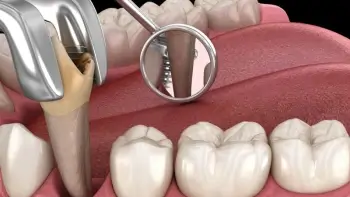
TOOTH EXTRACTION
What is Tooth Extraction?
Tooth extraction is the surgical removal of a tooth from its socket in the bone, performed by a dentist or oral surgeon as an outpatient procedure under local, general, or intravenous anesthesia, or a combination thereof. It is a relatively quick process.
Simple tooth extraction refers to the technique used to remove visible teeth in the mouth while the patient is under local anesthesia.
Why is a Tooth Extracted?
In adults, tooth extraction may be necessary in certain situations. Although it is ideal for permanent teeth to last a lifetime, extraction may be required for various reasons.
The most common reason is severe damage to the tooth due to trauma or decay that cannot be repaired. Additionally, dentists may recommend extraction in orthodontic cases where there are too many teeth for the jaw to accommodate, as a preparatory step. Similarly, impacted teeth, such as wisdom teeth that have not erupted through the gum, may require extraction.
If tooth decay or damage extends to the pulp—the core of the tooth containing nerves and blood vessels—bacteria in the mouth can enter, causing infection. While root canal treatment can often resolve this, extraction may be necessary if the infection is severe and antibiotics or root canal therapy are insufficient to prevent its spread.
Periodontal (Gum) Disease: If periodontal disease, an infection of the tissues and bones supporting the teeth, causes teeth to loosen, one or more teeth may need to be extracted.
Before Tooth Extraction
While tooth extraction is generally a safe medical procedure, it can introduce harmful bacteria into the bloodstream or increase the risk of infection in the gum tissue.
If there is a high risk of developing a severe infection due to another medical condition, antibiotics may be required before and after the extraction.
For this reason, patients must share their full medical history with the dentist before extraction. This includes regular medications, supplements, and conditions such as damaged or artificial heart valves, congenital heart defects, impaired immune systems, liver disease (cirrhosis), artificial joints (e.g., hip replacements), or a history of bacterial endocarditis, which must be reported to the dentist.
How is Tooth Extraction Performed?
Tooth extractions are performed by dentists or oral surgeons trained in surgical procedures. Before extraction, the dentist administers a local anesthetic injection to numb the area. In some cases, particularly for impacted wisdom teeth, a stronger general anesthetic may be used to eliminate pain and keep the patient asleep during the procedure.
The dentist will make an incision in the gum and bone tissue covering the tooth, then use forceps to grasp the tooth and gently rock it to loosen it from the jawbone and ligaments. In some cases, a difficult tooth may be removed in pieces.
Post-extraction bleeding is natural and necessary. A blood clot typically forms in the socket. The dentist places a gauze pad in the socket and asks the patient to bite down to help stop the bleeding. In some cases, the dentist may place a few self-dissolving stitches to ensure proper closure of the gum edges.
Occasionally, the blood clot in the socket may dislodge, exposing the bone and causing a painful and risky condition called dry socket (or septic socket). To promote healing, the dentist may place a pain-relieving paste containing antiseptics or antibiotics in the socket for a few days.
After Tooth Extraction
After a tooth is extracted, the dentist sends the patient home to recover. The healing process typically takes a few days. To minimize discomfort, reduce infection risk, and speed up recovery, patients can take the following steps:
Mild pain after extraction, as the anesthesia wears off, is normal. Some swelling and light bleeding are expected within the first 24 hours.
However, if bleeding or severe pain persists beyond four hours after extraction, contact the dentist. Seek immediate attention if you experience signs of infection (fever, chills), nausea, vomiting, redness, swelling, excessive discharge from the affected area, or symptoms like cough, shortness of breath, or chest pain.
Recovery After Tooth Extraction
Initial healing after tooth extraction typically takes one to two weeks, during which new bone and gum tissue grow in the socket. Over time, a missing tooth (or teeth) may cause remaining teeth to shift, affecting bite alignment and making chewing difficult. The dentist may recommend replacing the missing tooth with an implant, fixed bridge, or denture to address these issues.